ASD and Educational Provision
44 Pages13100 Words154 Views
Added on 2022-11-29
About This Document
This dissertation explores the concept of autism spectrum disorders and educational provisions for children with autism. It aims to evaluate whether educational provision meets the quality standards for children with autism. The methodology used is secondary research, including literature review and analysis of existing data. The findings highlight the challenges of disruptive behavior in children with autism and the genetic factors associated with the disorder. The research also examines the responsibilities of local authorities and educators in providing educational support for autistic children.
ASD and Educational Provision
Added on 2022-11-29
ShareRelated Documents
Dissertation Title: ASD and Educational Provision Research Question: Who
Provide Educational Provision for Children with Autism Spectrum
Disorders?
Provide Educational Provision for Children with Autism Spectrum
Disorders?

Table of Contents
Abstract................................................................................
Acknowledgements..............................................................
Chapter 1: Introduction.............................................................
1.1 What is Autism.........................................
1.2 Background..............................................
1.3 Aims and Objectives...................................
Chapter 2: Methodology...............................................................
Description of methodology
Description of quantitative and qualitative
Description of secondary Research
2.1Methodological approach Research pattern............
2.2 Ethical Consideration................................
2.3 Analytical Structures.......................................
2.4 Constructing a PICO Question...........................
2.6 Keywords.......................................................
2.7 Limitation......................................
Chapter 3: Literature Review........................................................
3.1 Introduction
Abstract................................................................................
Acknowledgements..............................................................
Chapter 1: Introduction.............................................................
1.1 What is Autism.........................................
1.2 Background..............................................
1.3 Aims and Objectives...................................
Chapter 2: Methodology...............................................................
Description of methodology
Description of quantitative and qualitative
Description of secondary Research
2.1Methodological approach Research pattern............
2.2 Ethical Consideration................................
2.3 Analytical Structures.......................................
2.4 Constructing a PICO Question...........................
2.6 Keywords.......................................................
2.7 Limitation......................................
Chapter 3: Literature Review........................................................
3.1 Introduction
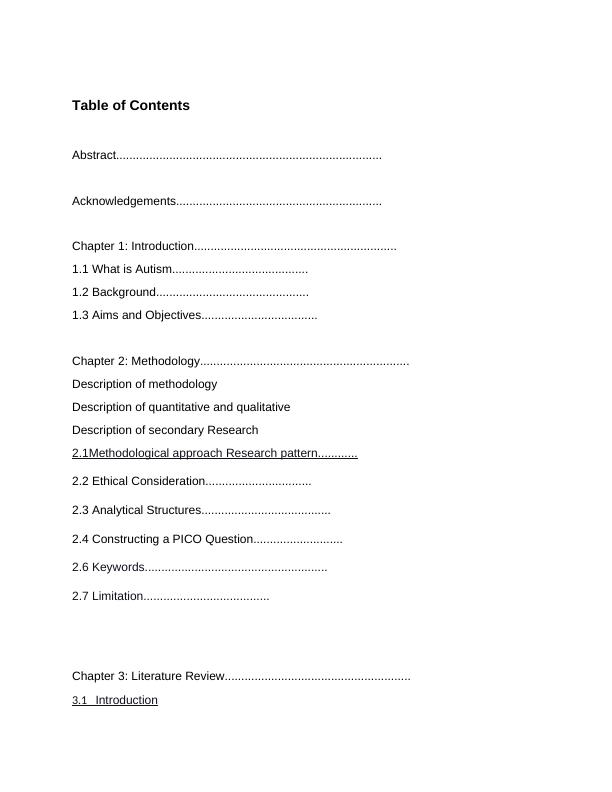
3.2 Children with Autism........................
3.3 Autism Type....................................
3.4 Pervasive Developmental Disorder...............
3.5 Asperger Syndrome......................................
3.6 Causes of Autism..............................................
3.7 Diagnosis and Treatment................................
3,8 Educational Provision for Autistic Children...........
3.9 Local Authorities Responsibilities and Roles In supplying Educational Provision for
Autism Childre.....................................................................
3.10 Provisions in mainstream schools and special need schools......
3.11 Health Care Expenditures Associated with Autism Spectrum Disorders........
Chapter 4: Results or Findings..................................................
4.1 Number One: Findings is Delay in Diagnoses.......................
4.2 Number Two: Findings is Behaviour Disruption...................
4.3 Number Three: Findings is on Cognitive Characteristic.........
4.4 Number Four: Oppositional Defiant Disorder...................................................
4.5 Number Five: Anxiety Disorders......................................................................
4.6 Number Six: ADHD ......................................................................................
4.7 Number Seven: Learning Disorder..................................................................
4.8 Number Eight: Sensory Processing Problems.............................................
4.9 Number Nine: It is not just genetic: it is epigenetic.......................................
4.10 Number Eleven: Shared Mechanism: a spectrum within a spectrum.............
3.3 Autism Type....................................
3.4 Pervasive Developmental Disorder...............
3.5 Asperger Syndrome......................................
3.6 Causes of Autism..............................................
3.7 Diagnosis and Treatment................................
3,8 Educational Provision for Autistic Children...........
3.9 Local Authorities Responsibilities and Roles In supplying Educational Provision for
Autism Childre.....................................................................
3.10 Provisions in mainstream schools and special need schools......
3.11 Health Care Expenditures Associated with Autism Spectrum Disorders........
Chapter 4: Results or Findings..................................................
4.1 Number One: Findings is Delay in Diagnoses.......................
4.2 Number Two: Findings is Behaviour Disruption...................
4.3 Number Three: Findings is on Cognitive Characteristic.........
4.4 Number Four: Oppositional Defiant Disorder...................................................
4.5 Number Five: Anxiety Disorders......................................................................
4.6 Number Six: ADHD ......................................................................................
4.7 Number Seven: Learning Disorder..................................................................
4.8 Number Eight: Sensory Processing Problems.............................................
4.9 Number Nine: It is not just genetic: it is epigenetic.......................................
4.10 Number Eleven: Shared Mechanism: a spectrum within a spectrum.............
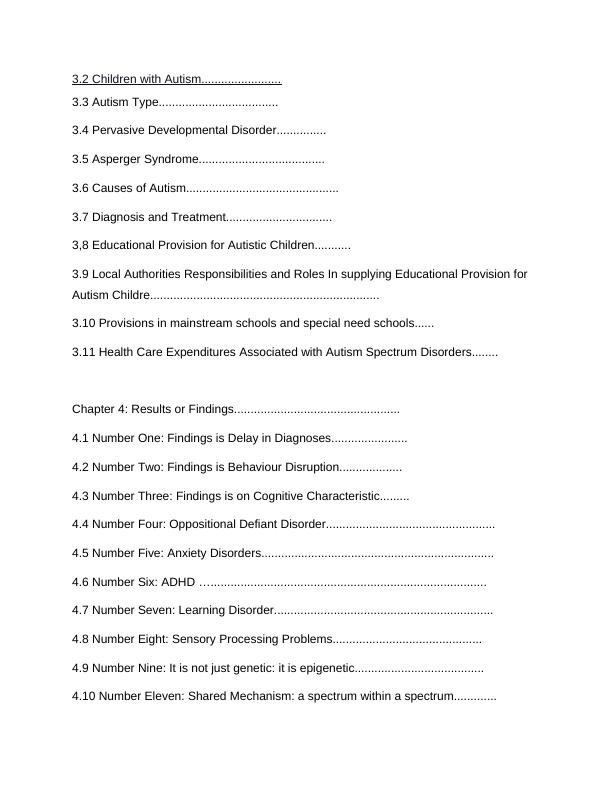
Chapter 5 Discussion....................................................
Chapter 6: Conclusion.......................................................................
Recommendation.................................................................................
References............................................................................................
Abstract
Autism spectrum disorder is a disorder for the lifelong that affects to the development
towards the behavior and the communication of the individual. There are different
symptoms and its effect is different in the different people. With the several medications
it can be cure like nauroleptics that treated the behavioral problems.
Thelocal authority and educators has to prove the proper education and the special
needs for those children and this need should be made possible, this must take place in
inclusive surroundings with those children that do not have the same need. The local
authority and others to make sure they provide educational need that will enable them
to have access on the same right with their grade to benefit from by carrying them along
without exclusion. To support the children with special educational needs that will help
them got skills to take part or become involved in an activity to level of their limit, so that
they can also work effectively in the social and the economic activities that happens in
the community in their own way and with the satisfied life (Educational Act 2004).
Chapter 6: Conclusion.......................................................................
Recommendation.................................................................................
References............................................................................................
Abstract
Autism spectrum disorder is a disorder for the lifelong that affects to the development
towards the behavior and the communication of the individual. There are different
symptoms and its effect is different in the different people. With the several medications
it can be cure like nauroleptics that treated the behavioral problems.
Thelocal authority and educators has to prove the proper education and the special
needs for those children and this need should be made possible, this must take place in
inclusive surroundings with those children that do not have the same need. The local
authority and others to make sure they provide educational need that will enable them
to have access on the same right with their grade to benefit from by carrying them along
without exclusion. To support the children with special educational needs that will help
them got skills to take part or become involved in an activity to level of their limit, so that
they can also work effectively in the social and the economic activities that happens in
the community in their own way and with the satisfied life (Educational Act 2004).
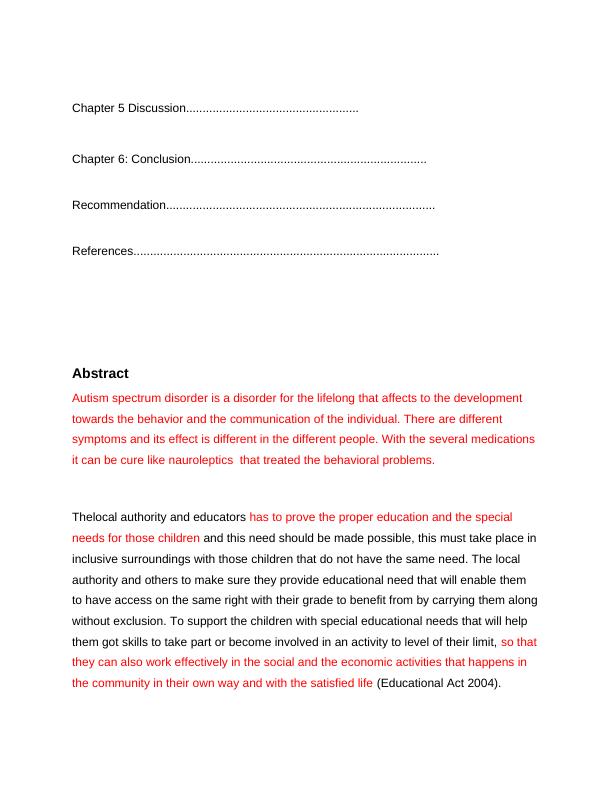
The aim of this current project is to find people that are responsible and their role in
providing educational provision for autistic children with special needs and the goal is to
discover To evaluate whether educational provision meet the quality standard of
education that are given to the children that are suffering from the Autism spectrum
disorder. This goal will cover assessment, early intervention, diagnosis, limitations,
findings and prevalence of children with autism.
The method of approach used for this current project is based on secondary literature
review research written by other researchers, abstract form google scholar, online
website, journal articles to get a good result of the research question which relate to
autism spectrum disorders.
There are few findings or results found from the literature review research such are;
children with autism have a disruptive behaviour which is quite challenging for both
parents and teachers at school and secondly, researchers found that approximately
over the 150 genes that are to be linked with the autism. With the changes in the layer
of genome that is termed as epigenome, scientist found the risk is appear more with the
change in this layer.
Acknowledgements
Thanks to the lecturers, course mates for all their help and encouragement in making
sure that the dream expectation of this current project come true without giving up on it,
see this project through start to finish even though there are ups and down. There are
other people at the Center to thank for their time, generosity and thoughtfulness is also
acknowledged with gratitude. In doing of this current project, have help to enhance the
knowledge of understanding health and social science course level 3 foundation which
relate to human being day to day activities.
providing educational provision for autistic children with special needs and the goal is to
discover To evaluate whether educational provision meet the quality standard of
education that are given to the children that are suffering from the Autism spectrum
disorder. This goal will cover assessment, early intervention, diagnosis, limitations,
findings and prevalence of children with autism.
The method of approach used for this current project is based on secondary literature
review research written by other researchers, abstract form google scholar, online
website, journal articles to get a good result of the research question which relate to
autism spectrum disorders.
There are few findings or results found from the literature review research such are;
children with autism have a disruptive behaviour which is quite challenging for both
parents and teachers at school and secondly, researchers found that approximately
over the 150 genes that are to be linked with the autism. With the changes in the layer
of genome that is termed as epigenome, scientist found the risk is appear more with the
change in this layer.
Acknowledgements
Thanks to the lecturers, course mates for all their help and encouragement in making
sure that the dream expectation of this current project come true without giving up on it,
see this project through start to finish even though there are ups and down. There are
other people at the Center to thank for their time, generosity and thoughtfulness is also
acknowledged with gratitude. In doing of this current project, have help to enhance the
knowledge of understanding health and social science course level 3 foundation which
relate to human being day to day activities.
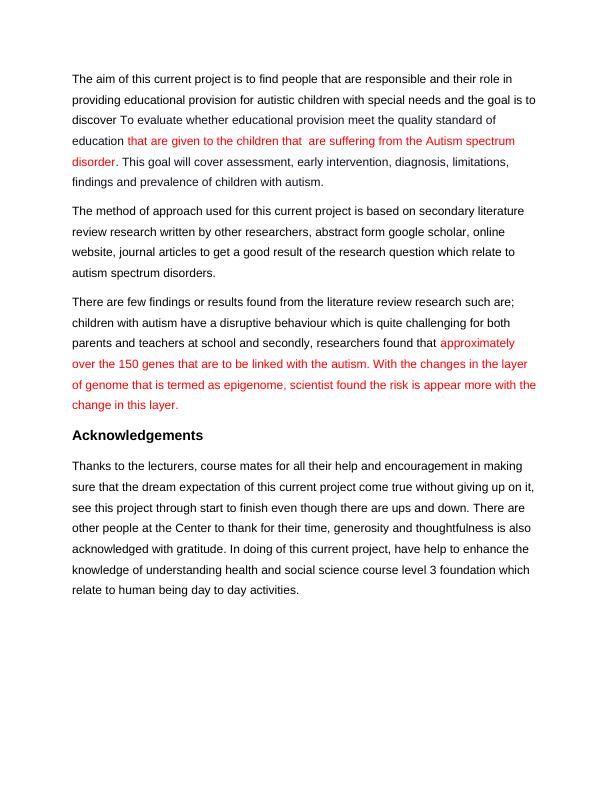
Chapter 1: Introduction
This current project will explore the concept of autism spectrum disorders and
educational provisions for children with autism together with other relevant words that
relate to the chosen topic of interest. It will highlight the aims and goals of this current
project and the background of autism spectrum disorders, it includes the research
question which is, Who Provide Educational Provision for Autism Children and will also
talk about the method system of approach together with PICO that was used to
formulate questions. It will also to find any gap in knowledge, result, weaknesses,
strength, findings and limitation.
1.1 What is autism?
The term autism that is also known from the name of Pervasive Developmental disorder
(PDD) is a general term that is used for describing the complex development of the
disorder that occurs in the brain of the person. This disorder is developed in the early
childhood of the person and gets difficulty to the person to do communication and
forming in the relationship with the others. It was first described in the year 1943 by the
Leo Kanner. He emphasis on the three key areas that people are suffering from the
disease can exhibit that is social isolation, insistence and abnormal language.
(Fischbach Gerald, 2007).
According to Leo Kanner, it is disorder that is developed from the early childhood or
from the birth till the life of the individual and it affects to the human behavior that are
interaction with the society, communication of the ideas and the feelings with the people
and building the relationships. It affects to the long life to the children that are affecting
from the disorder to keep the care of themselves, to be active with the community by
taking part and learn interaction with the society. It is a disorder that is origin from the
neurobiological that is based on the features of the developmental and the behavior. As
the causes of the Autism are not known yet and has link directly between the behaviour
and pathophysiology that is still rare and not influences effectively on the treatment and
the diagnoses. With the current research of biologics, like the genetics, it gives the
important implication to the families of the children suffering from the disorder.
(Fischbach Gerald, 2007).
This current project will explore the concept of autism spectrum disorders and
educational provisions for children with autism together with other relevant words that
relate to the chosen topic of interest. It will highlight the aims and goals of this current
project and the background of autism spectrum disorders, it includes the research
question which is, Who Provide Educational Provision for Autism Children and will also
talk about the method system of approach together with PICO that was used to
formulate questions. It will also to find any gap in knowledge, result, weaknesses,
strength, findings and limitation.
1.1 What is autism?
The term autism that is also known from the name of Pervasive Developmental disorder
(PDD) is a general term that is used for describing the complex development of the
disorder that occurs in the brain of the person. This disorder is developed in the early
childhood of the person and gets difficulty to the person to do communication and
forming in the relationship with the others. It was first described in the year 1943 by the
Leo Kanner. He emphasis on the three key areas that people are suffering from the
disease can exhibit that is social isolation, insistence and abnormal language.
(Fischbach Gerald, 2007).
According to Leo Kanner, it is disorder that is developed from the early childhood or
from the birth till the life of the individual and it affects to the human behavior that are
interaction with the society, communication of the ideas and the feelings with the people
and building the relationships. It affects to the long life to the children that are affecting
from the disorder to keep the care of themselves, to be active with the community by
taking part and learn interaction with the society. It is a disorder that is origin from the
neurobiological that is based on the features of the developmental and the behavior. As
the causes of the Autism are not known yet and has link directly between the behaviour
and pathophysiology that is still rare and not influences effectively on the treatment and
the diagnoses. With the current research of biologics, like the genetics, it gives the
important implication to the families of the children suffering from the disorder.
(Fischbach Gerald, 2007).

With the research it is founded that with the Autism Spectrum Disorder represents with
the health issues in the public having in the 1 percent in the United States children that
are diagnosed with this disorder. People suffering from the ASD having the symptoms
that are to be associated with the medical conditions that are problem in sleeping,
seizures, metabolic conditions and the gastrointestinal disorder. That affects on the
development of social, education and the health impact. Problem that is gastrointestinal
is the major concern for the parents and also to the behavioural problems and other
issues like deregulated sleep. In addition, if any child notice to have a sign of developing
autism which means early dislike and being diagnosed of autism, a suitable assessment
must begin for that child (Daniel et al., 2012).
1.2 Background
Autism is also known as Asperger syndrome spectrum disorder. It is a diagnostic term
that official came onto the professional scene in 1994 within the diagnostic statistical
manual (DSM) IV and later sub named under the category of autism spectrum disorder
(ASD). This disorder is based in the neurological condition that means the people who
are suffering from this have from the birth and it should be for lifetime nevertheless, as
some of them grow into adulthood, is possible they may gain new skills and is they will
also outgrow some of the traits or use their strength to recoup their area of disorder
(Autism society, 2020).
According to Merlyn Krich and Lauren Wollschlager said that from the autism research
institute, autism is at a fast rate which is mainly common within children. Autism
prevalence in many years past, was unusual which just happen that 5 out of 10,000
children were affected with autism. In addition, from the year 1990s, the prevalence rate
of autism has been increasing in large amount throughout the globe. In March 2012, the
united states of America the federal centres for disease control said that 1 out of 88
children in USA has been confirmed with autism spectrum disorder which shows that as
many as 1.5 million Americans till this present day considered to experience autism.
the health issues in the public having in the 1 percent in the United States children that
are diagnosed with this disorder. People suffering from the ASD having the symptoms
that are to be associated with the medical conditions that are problem in sleeping,
seizures, metabolic conditions and the gastrointestinal disorder. That affects on the
development of social, education and the health impact. Problem that is gastrointestinal
is the major concern for the parents and also to the behavioural problems and other
issues like deregulated sleep. In addition, if any child notice to have a sign of developing
autism which means early dislike and being diagnosed of autism, a suitable assessment
must begin for that child (Daniel et al., 2012).
1.2 Background
Autism is also known as Asperger syndrome spectrum disorder. It is a diagnostic term
that official came onto the professional scene in 1994 within the diagnostic statistical
manual (DSM) IV and later sub named under the category of autism spectrum disorder
(ASD). This disorder is based in the neurological condition that means the people who
are suffering from this have from the birth and it should be for lifetime nevertheless, as
some of them grow into adulthood, is possible they may gain new skills and is they will
also outgrow some of the traits or use their strength to recoup their area of disorder
(Autism society, 2020).
According to Merlyn Krich and Lauren Wollschlager said that from the autism research
institute, autism is at a fast rate which is mainly common within children. Autism
prevalence in many years past, was unusual which just happen that 5 out of 10,000
children were affected with autism. In addition, from the year 1990s, the prevalence rate
of autism has been increasing in large amount throughout the globe. In March 2012, the
united states of America the federal centres for disease control said that 1 out of 88
children in USA has been confirmed with autism spectrum disorder which shows that as
many as 1.5 million Americans till this present day considered to experience autism.
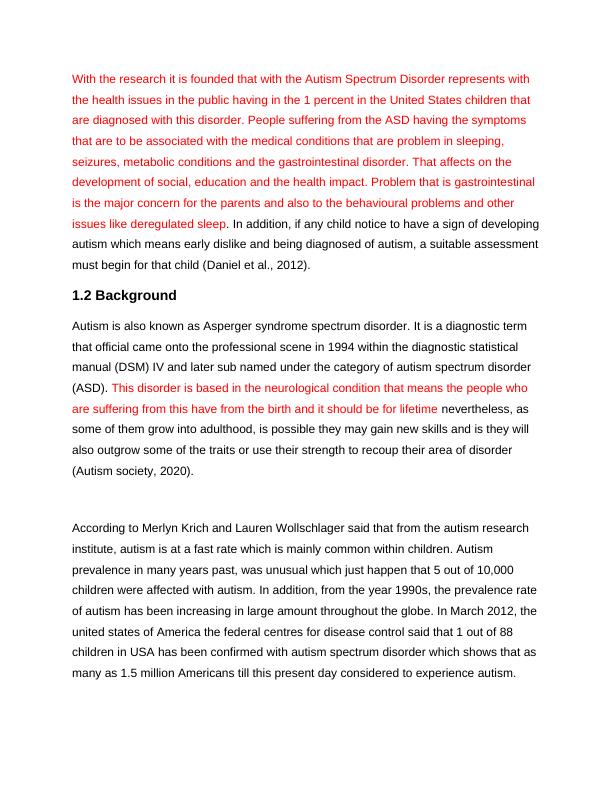
ASDs are found in all socioeconomic ethnicity, and age groups. It is said that boys are
suffering 5 times more than the girls from this disorder.
From the finding in the 2014 it is marked that ASD prevalence have the variations when
it is formed by the geographical are, sex and the level of ability of the intellectuality. With
the differences in the prevalence it is founded in the black and white children in the
declining in most of the areas but in the Hispanic children it can be noticed. In the 2014,
the results came from the application of DSM- IV-TR and DSM-5 cases were the similar.
It can be stratiform by the sex, race, DSM-IV-TR subtype and to the level of the ability of
intelectualty.(Baio J et al., 2018).
Stephen Wiltshire was mute and could not associated with other people. At the age of
three Stephen was diagnosed and were affected with autism or become autistic, had no
language, who entirely lived alone in a different world. Stephen happened to be born on
April 1974 in London precisely United Kingdom by west Indian parents.
Stephen at the age of 5 years old, was sent to Queen-smile school in London where
everything about Stephen came into light through an instructor at Queens-mile who
encouraged Stephen to speak and the who gave pen to write something by taking away
Stephen art tools, responded by saying a word and was learned to speak fully at the of
9 years old that suddenly became strongly attracted with London buildings landmark
sketching. One of the teachers was interested about Stephen by going along with
Stephen whilst as to be the young children who did the drawing in the leisure activity by
entered in the completion of the children artwork and gained many awards to the
Stephen. The local press became more sceptical of Stephen early age could construct
such articulate drawings (Wiltshire Stephen, 2021).
Aims
The aim of this current project is to find out the people that are responsible and their
roles in providing educational provision for children with autism spectrum disorders and
suffering 5 times more than the girls from this disorder.
From the finding in the 2014 it is marked that ASD prevalence have the variations when
it is formed by the geographical are, sex and the level of ability of the intellectuality. With
the differences in the prevalence it is founded in the black and white children in the
declining in most of the areas but in the Hispanic children it can be noticed. In the 2014,
the results came from the application of DSM- IV-TR and DSM-5 cases were the similar.
It can be stratiform by the sex, race, DSM-IV-TR subtype and to the level of the ability of
intelectualty.(Baio J et al., 2018).
Stephen Wiltshire was mute and could not associated with other people. At the age of
three Stephen was diagnosed and were affected with autism or become autistic, had no
language, who entirely lived alone in a different world. Stephen happened to be born on
April 1974 in London precisely United Kingdom by west Indian parents.
Stephen at the age of 5 years old, was sent to Queen-smile school in London where
everything about Stephen came into light through an instructor at Queens-mile who
encouraged Stephen to speak and the who gave pen to write something by taking away
Stephen art tools, responded by saying a word and was learned to speak fully at the of
9 years old that suddenly became strongly attracted with London buildings landmark
sketching. One of the teachers was interested about Stephen by going along with
Stephen whilst as to be the young children who did the drawing in the leisure activity by
entered in the completion of the children artwork and gained many awards to the
Stephen. The local press became more sceptical of Stephen early age could construct
such articulate drawings (Wiltshire Stephen, 2021).
Aims
The aim of this current project is to find out the people that are responsible and their
roles in providing educational provision for children with autism spectrum disorders and
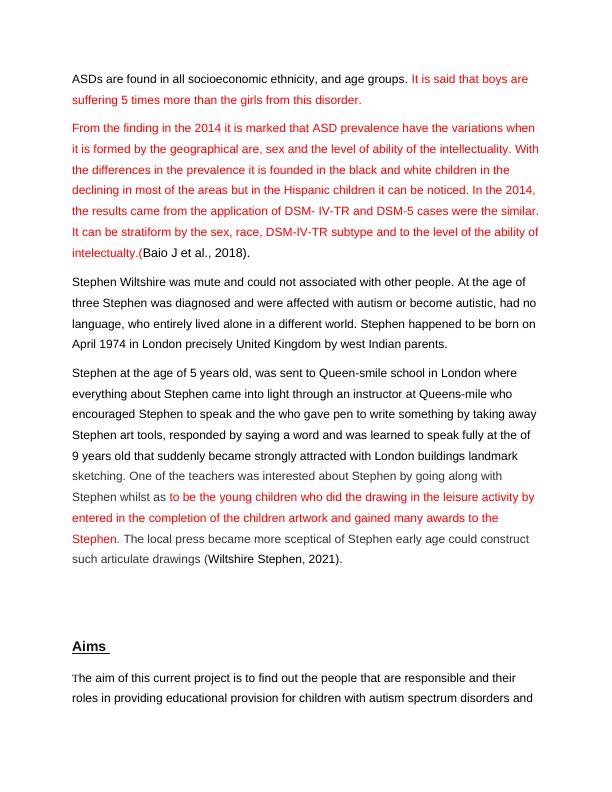
End of preview
Want to access all the pages? Upload your documents or become a member.
Related Documents
Evaluate the level of educational and psychological support for children with Autismlg...
|39
|11713
|492
Role of Teacher Assistant in Special Education Schoollg...
|41
|15601
|244
Health and Social Care Report- Autism Childrenlg...
|21
|5059
|261
A Business Plan for Autistic Childrenlg...
|8
|1921
|497
Study of support applications for the Autistics Children’slg...
|45
|15162
|82
Autism in Children: Guidance and Support in the UKlg...
|13
|3830
|51
